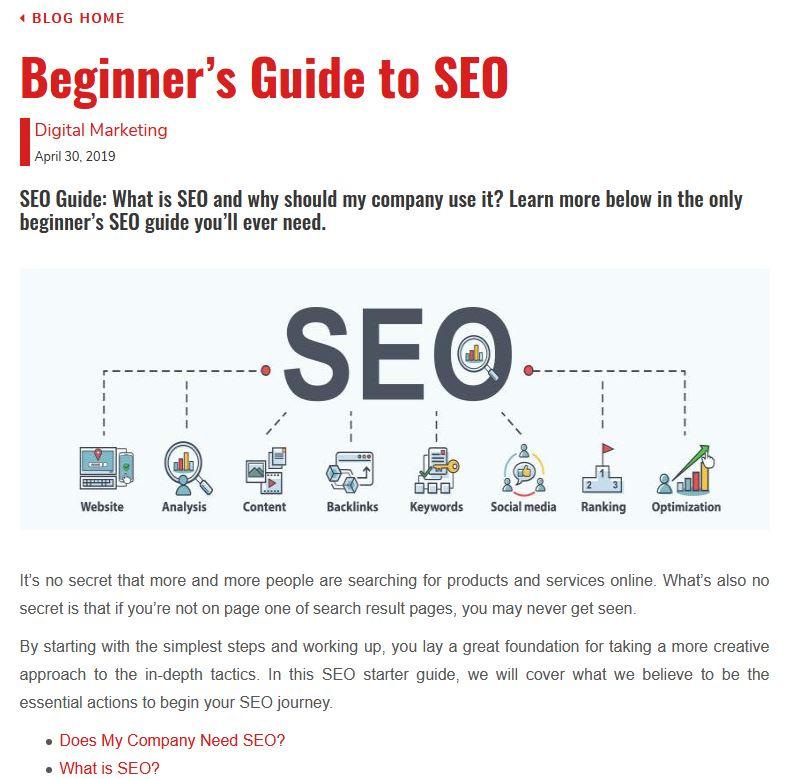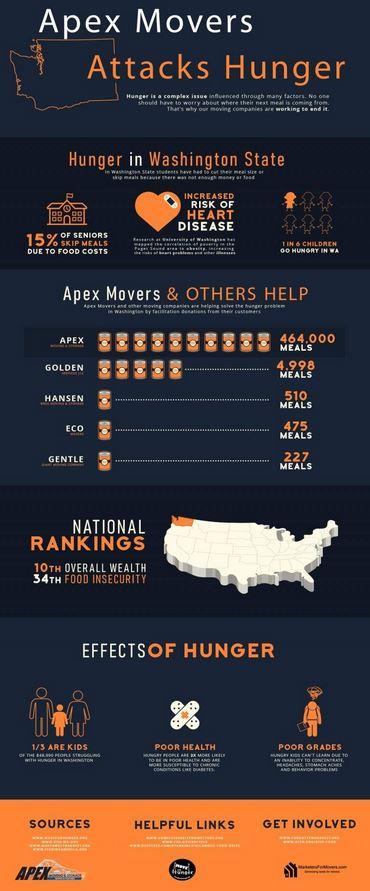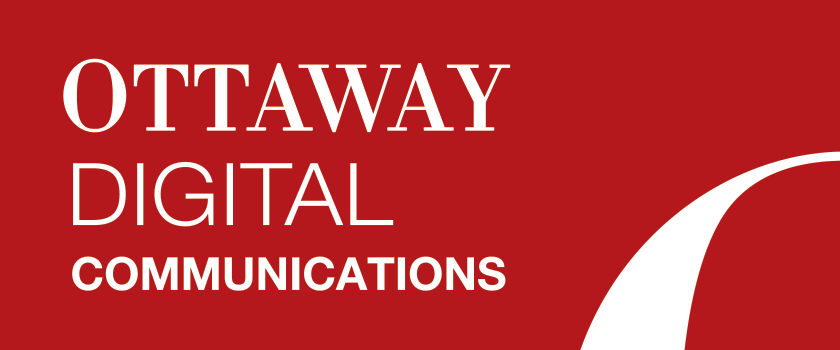
If your Detroit business chooses to invest in content marketing, you’re choosing to actively take a role in getting to know your audience better, which allows you to potentially convert more leads and increase your brand awareness.
You must be wondering why content marketing is important.
For your audience: Creating and implementing an effective content marketing strategy gives your target audience a neat little package that has the answers to their needs and wants.
For marketers: It helps us better understand our audience so that we can reach them on their level and always keep them interested.
So, what needs to happen?
The content you create must provide valuable, relevant and consistent information to your target market.
BASICS OF CONTENT MARKETING
How exactly does one provide valuable, relevant and consistent content?
It’s easy if you think about it like you’re telling a story.
Each page of the story is a piece of content telling your audience about your organization and your products and/or services.
You’re also letting them know that they can benefit not only from using the service or product, but from the experience meeting with you and your team.
WHAT IS CONTENT MARKETING?
Content marketing is the strategy we marketers use to actualize marketing goals like:
- Acquiring leads.
- Brand and/or product awareness.
- Launching a new product/service.
- Re-brand or re-position.
- Increase web traffic.
WHY IS CONTENT MARKETING IMPORTANT IN SEO?
Content marketing and SEO aren’t as separate as we’ve been led to believe.
Although they vary in some areas, by using the two in combination, the likelihood of realizing our marketing goals increases.
As Neil Patel simply puts it, “Think of it [the relationship between SEO and content marketing] as a conversation between two people.”
SEO: “Hi, my name is SEO, and I need you to ___.”
CONTENT MARKETING: “Hey, I’m Content Marketing. I’ll do that for you.”
SEO and content marketing can be thought of as supply and demand, where SEO demands the use of specific keywords, and content marketing fulfills that need.
CONTENT MARKETING AND BACKLINKS
Content marketing also allows for you to reach out and acquire quality backlinks for your content which are key for having a high-authority domain and website. Backlinks are looked at when Google is ranking your site for search results pages, so if you have backlinks from sites that have high authority, it can boost the authority of your own site which will ultimately rank you higher on results pages.
One thing to keep in mind is to make sure you have backlinks that are relevant to your business. If you have a backlink from a high-authority site that has nothing to do with your product or service, that backlink could hinder more than help you.
EXAMPLES OF CONTENT MARKETING
Content marketing is all about using that unique content to attract and retain a prospect that will eventually become a customer.
If you’re running out of content ideas or you’re not sure where to start, our content marketing guide is sure to jump start those creative juices.
There are several pieces of content anyone can incorporate into their organization’s business plan.
In no particular order, here are a few of the more popular choices of content marketing:
BLOGGING
When most people think of content marketing, blogging is a popular go-to for most marketers, and why not?
Blogging helps you get visitors’ attention with helpful information and provides content to give your social media presence more “oomph.”
It also helps you snag those keywords you might be otherwise looking to rank for on Google.
In any case, each blog may have different goals to fulfill, such as:
- Choosing to promote another’s blog content by backlinking to various posts.
- Updating the current audience with industry-relevant facts via social posting.
- Linking to a partner’s websites and products.
- Writing about new or discounted services and/or products.
For instance, as you can see below our Beginner’s Guide to SEO was created to fulfill the specific goal of giving our audience a comprehensive guide that breaks down all the complicated bits of SEO.
VIDEO
Video marketing drives brand awareness, leads and sales, so it’s no surprise that so many content marketing strategies praise videos.
Recent HubSpot research found that “…over 50% of consumers…” prefer video marketing from brands they support compared to other marketing methods, like newsletters or blog articles.
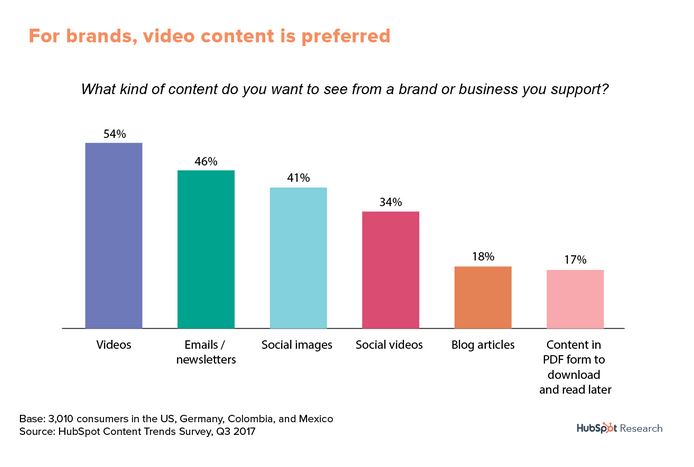
SOCIAL MEDIA POSTS
According to a Statista report on the number of social network users worldwide from 2019, “…an estimated 2.95 billion people were using social media worldwide, a number projected to increase to almost 3.43 billion in 2023.”
Which is why many companies have focused on social media marketing methods to keep their current audience interested, as they are looking to increase their overall target audience pool.
Social shares can help drive engagement by giving your audience content to interact with, thus increasing brand awareness by either “liking” or “sharing” a post.
Using a web analytics tool like Google Analytics to track demographic data gives a company a better understanding of how to gear its social media posts.
EMAIL MARKETING
Email marketing a fantastic way to get the right content in front of the right people.
In fact, HostPapa shows that a third of marketers send out 3-5 emails per week.
The catch? You can’t just plop stuff in front of your audience and expect them to bite.
Like fishing, you must use the right lure.
To do that, you need to create content that speaks to the needs and wants of your audience.
Most newsletters include company updates on services and/or products or the latest in industry-relevant news which helps translate into your expertise on the matter at hand.
No matter what, you should always give the people what they want—that includes an unsubscribe button. Otherwise you’re wasting content.
For instance, we distribute a weekly newsletter (below) that touches on SEO, lead acquisition stats and more digital marketing trends:
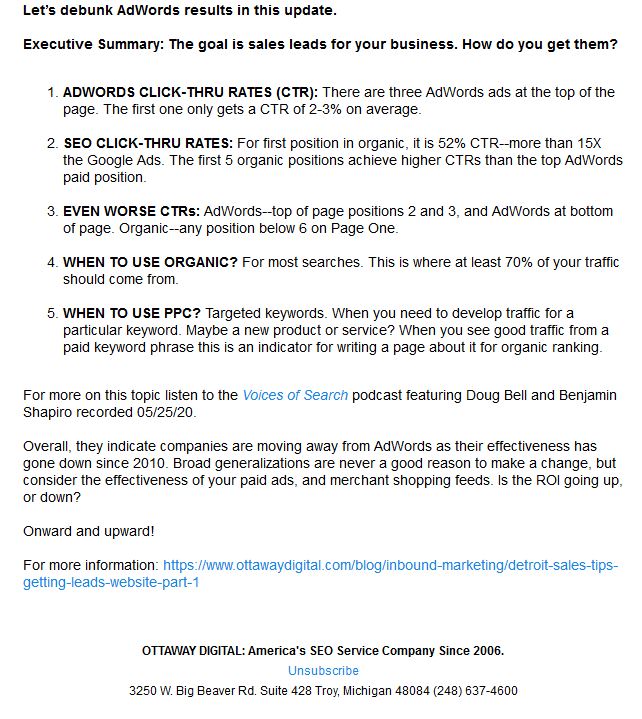
INFOGRAPHICS
Infographics are engaging graphs that summarize complex topics in an easy-to-digest format for the masses.
Because they are easier to understand than a lengthy article, “Infographics are the fourth most used type of content marketing” according to Hubspot.
The way people consume information has changed and they desire information in a nicely wrapped package without too much fuss.
CONTENT MARKETING STRATEGY
- Set your mission and goals.
- Establish your KPIs.
- Get to know your audience.
- Choose the optimal content channels.
- Create and distribute your content.
- Measure and analyze your results
SET YOUR MISSION & GOALS
Your first and most optimal starting point is to create a mission statement outline to help keep yourself on track regarding your content marketing strategy.
The outline should consist of:
- Your target audience.
- The content you’ll use to reach them.
- The benefit your audience receives from said content.
Your goals should be specific to your business but could help support your overall marketing goals.
Examples of goals for your content strategy may include:
- Brand awareness
- Increase lead generation
- Customer engagement
- B2B partnerships
ESTABLISH YOUR KPIs
You’ll find it much easier to achieve your goals if you make them achievable and specific.
Your key performance indicators (KPIs) are quantifiable data points which you can use to track your performance against the goals you’ve set.
Most KPIs include what you plan to achieve in terms of revenue, awareness, conversions, engagement and other aspects of digital marketing.
Generally, there are numbers attached to each KPI.
For example, you might want to track:
- Daily sales/site traffic within a month, year, etc.
- Brand awareness via subscription sign-ups, social mentions/followers, site traffic, etc.
- Customer engagement by visiting the site, social media platform, opening emails, participating in virtual/life events, etc.
GET TO KNOW YOUR AUDIENCE
Earlier we mentioned that your outline should consist of your target audience.
Learning about your audience is a surefire way to help you create content specifically geared toward them.
To do that, you need to use web analytics to collect all the demographic data you could ever need.
Luckily, Google Analytics tracks that information and can give you details on data like:
- Age
- Gender
- Education
- Income
Social media platforms like Facebook and Twitter can also offer ways to track demographic data based on who has shared which posts.
To learn even more about your audience, consider getting feedback from your customers.
Google or Yelp reviews are a great way to flesh out constructive criticism about your company to help you understand what your audience’s most urgent needs are, so you can quick get to work solving their problems.
With the demographic and feedback data collected, your next step should be to create a buyer persona of your ideal customers and/or readers.
The buyer persona should consist of specific pain points, challenges, sources of information and behavioral motivators so you can target your customer better.

The persona can help you better understand the content your audience will respond to, how it will help them, and what you can do to make them care about it.
CHOOSE THE OPTIMAL CONTENT CHANNELS
As you work your way through this process, you’ll start to understand where your audience typically “hangs out” and where you brand is visible the most.
Whether it’s Google, Facebook, LinkedIn, Twitter or Instagram, you’ll want to be sure you choose the right channel to get a higher chance of engagement and social shares.
Google Analytics can help you determine where your content is being shared the most to help guide you in picking the right platform.
In some cases, the channel you need to choose will be obvious (e.g. LinkedIn for B2B customers).
DECIDE ON CONTENT TYPE
If you created the buyer persona, it will tell you all sorts of information to help you decide on what content to create, including:
- What they need from you (pain points)?
- What are they looking to overcome (challenges)?
- Where did they find your product and/or service (sources of information)?
- How can you help them (behavioral motivators)?
If not, you’ll need to do a fair bit of research to figure it out, but luckily for you, we laid out different types of marketing content earlier in this piece.
CREATE & DISTRIBUTE
Now’s the time to finally create and put forth your content!
If it’s something you’re sending out frequently, make sure you have a calendar set up with your specific launch dates. This can help you and your team stay on top of analyzing your results.
MEASURE & ANALYZE YOUR RESULTS
Until the very end, you’ll want to ensure you keep consistently tracking and measuring your results, in case your content needs to be freshened up or updated with critical information.
Look back at your mission, goals and KPIs. Track them against your data from your web analytics tool. Did you meet your goals? Are close to reaching them, or were your numbers off?
If some goals didn’t pan out, don’t fret. Simply modify your framework by removing what didn’t work and repeat the process.
KEEPING YOUR AUDIENCE INTERESTED WITH CONTENT MARKETING
We hope that our ultimate framework for content marketing has helped you understand that giving your audience valuable, relevant and consistent content can help with things like:
- Boosting user engagement
- Increasing brand awareness
- Building relationship with prospective leads and
- Increasing conversion rates
All you’ll need to do now is choose which type of content to create and work hard to create the perfect content for you.
